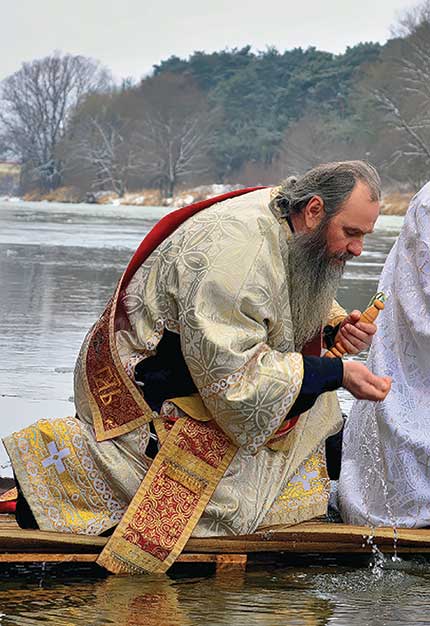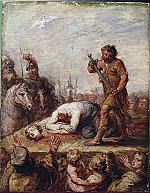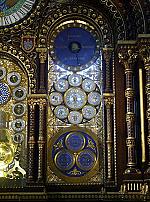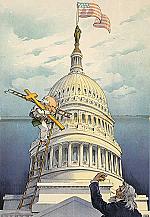Distinctives of the East

[ABOVE: Great Blessing of the Water, Sanok, Poland. 2013—Silver / [CC BY-SA 3.0] Wikimedia]
Throughout this guide we have made references to differences between Protestant, Catholic, and Orthodox liturgy. Here’s a handy guide to some distinctive aspects of Eastern versus Western liturgy.
Different names
The weekly celebration of the Eucharist in the West goes most often by the names “Mass” (in Roman Catholicism), or “Holy Eucharist,” and “Holy Communion” (among Protestants). In the East it is called the “Divine Liturgy.” Matins and Vespers in the East align with Morning and Evening Prayer in the West; however, they play a much larger role in most Orthodox congregational worship than the corresponding Western services do. Also, fasts and feasts often have different names and emphases. Sometimes they share an almost exact equivalence—as between Epiphany and Theophany or Easter and Pascha—and sometimes, a greater difference is apparent (the Nativity Fast is longer than Advent, Ash Wednesday and Clean Monday mean different things and are observed differently, etc.)
Different schedules
While the church year in Orthodoxy follows a similar basic shape, it differs in a few important ways. One is that the liturgical year is traditionally considered to begin in September. A second is that the Julian calendar is used to set some important liturgical dates, which means that equivalent feasts to Western ones may not occur on the same day, Easter/Pascha being the most widely known.
Finally, Orthodox worship revolves around the church’s Great Feasts in a way that has no exact equivalent in the West. East and West share a commitment to Easter/Pascha as the most important and supreme feast, but after that, Orthodox worship focuses on 12 Great Feasts in particular:
• January 6: Epiphany/Theophany
• February 2: The Presentation of Christ in the Temple
• March 25: The Annunciation
• Palm Sunday
• The Ascension of Christ
• Holy Pentecost
• August 6: The Transfiguration of Christ
• August 15: The Dormition (falling-asleep, i.e., death) of the Theotokos (Mary)
• September 8: The Nativity of the Theotokos
• September 14: The Exaltation of the Cross
• November 21: The Entrance into the Temple of
the Theotokos
• December 25: The Nativity of Christ
Most of these feasts have a day or two of preparation called a “forefeast,” and all of them have at least half a day of celebration afterward, called an “afterfeast.” Some feasts are also followed by a saint’s day connected with the feast; this is called a Synaxis. (For example, the Synaxis of the Forerunner, John the Baptist, is celebrated the day after Epiphany.) Five other feasts are also a part of the Great Feasts but not numbered among the 12:
• January 1: The Circumcision of Christ
• June 24: The Nativity of St. John the Baptist
• June 29: The Feast of Saints Peter and Paul
• August 29: The Beheading of St. John the Baptist
• October 1: The Intercession of the Theotokos
Turn the page for more on saints’ days in East and West.
By Jennifer Woodruff Tait
[Christian History originally published this article in Christian History Issue #156+ in 2025]
Jennifer Woodruff Tait is Senior Editor of CH magazineNext articles
Celebrating the saints: the sanctoral cycle
Saints are normally honored on the anniversary of their death
Jennifer Woodruff TaitRecommended resources: Fasts and Feasts
Learn more about the history of the Christian year, and get ideas for incorporating celebrations into your own life.
The editorsQuestions for reflection: Fasts and feasts of the church
Reflect on themes of sacred time.
The editorsDid you know? Vatican II
A helpful introduction to terms and ideas as you begin the Vatican II story
the editorsSupport us
Christian History Institute (CHI) is a non-profit Pennsylvania corporation founded in 1982. Your donations support the continuation of this ministry
Donate







